Yes, the rumors you heard are true. That 1934 $20 bill you found in your grandparent’s cabinet could be worth far more than its face value of $20. All it takes is being privy to the correct information.
Generally, the grade and condition of a 1934 dollar bill would either rack up or pull down its value. However, there are other factors that determine these bills’ value. Hence, we’ve made it our duty to provide you with expert information on what determines the value of a 1934 $20 bill.
1934 $20 Bill Details
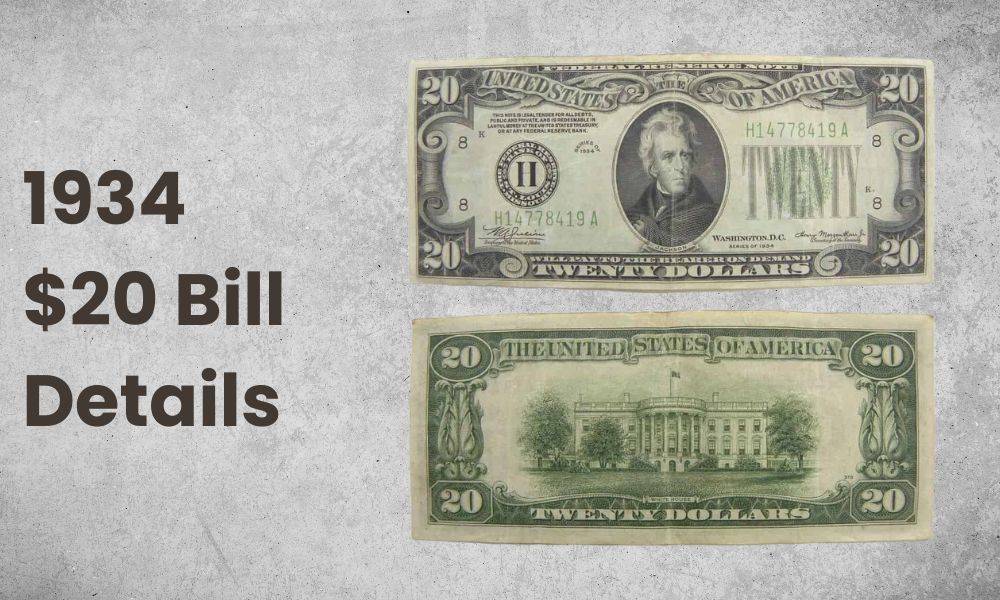
- Category: Federal Reserve Note
- Series: Green (1934, 1934A, 1934B, 1934C, 1934D), Brown
- Seal Colors: Green, Brown (Hawaii Notes)
- The Designer: The US Bureau of engraving and printing
- Obverse Design: Andrew Jackson
- Reverse Design: The White House
- Composition: Three-fourths cotton and one-fourth linen
- Security Feature: Red and blue security fibers and raised printing
- Face Value: $20
- Width: 6.14062 inches (156 mm)
- Height: 2.60937 inches (66.28 mm)
- Weight: 0.03527 ounces (1 g)
1934 $20 Bill spelled the end of the gold certificate banknotes, which came onto the scene in 1928. Fortunately, recognizing the regular and Hawaiian series of these 1934 $20 bills shouldn’t be difficult because of their similar features.
Obverse
Starting from the external portion of the obverse of the 1934 $20 bill, you’ll find the $20 value of the 1934 $20 bill is indicated along the bill’s edges. Next, the words Federal Reserve Note is written at the top center portion, while “Will Pay to Bearer on Demand Twenty Dollars” is written at the bottom center position.
Moving inwards of the obverse, you’ll notice an open scroll-like design. It is a portrait of the 7th President of the United States of America, Andrew Jackson. Here, his portrait is centered, and to the right is the treasury seal, while on the left, you’ll find the note’s serial number and the Federal Bank Reverse seal above this number.
The serial number represents that these notes were for all twelve federal districts, which include Boston, Philadelphia, San Francisco, Chicago, Minneapolis, New York, St. Louis, Dallas, Cleveland, Atlanta, Richmond, and Kansas City.
Reverse
The reverse is beautifully designed with trees surrounding the white house, and the face value of the bill on the four edges of the bill is similar to the obverse. Here you’ll find the words “United States of America” and “Twenty Dollars” written at the mid-top and mid-bottom parts of the reverse, respectively.
Other Notable Details
Here are some notable details worth mentioning:
The Seal
The seal on the 1934 $20 bill depends on the note variety in question. 1934, 1934A, 1934B, 1934C, and 1934D bills all possess a green treasury seal on the right of the note; the 1934 and 1934A $20 Hawaii Pearl Harbor notes feature a brown seal.
The Serial Number
Another detail worth noting is the serial numbering on the $20 bills. It is a two-letter and 8 digits combination featured on the note’s obverse at both the top right and lower left sides. The numbers in the serial arrangement are used to determine the series year, while the letters help track down which Federal Bank Reserve (A-L) printed the note.
There are notes, however, with a star symbol in place of the last letter. This is used to indicate an error on the original note, and since no two notes can have the same serial number, the new star note replaces the damaged bill.
In addition, certain serial number combinations of the 1934 $20 bill are valuable to collectors. Show up with one of these, and you could walk away with as much as $15,000.
Here is a list of ten examples of these kinds of serial numbers
- Number 1 serial – A00000001A, valued at $15,000
- Low serial numbers from 100 or 1,000 (A00000099A or A00000999A)
- High serial numbers (A99999900A and higher)
- Perfect down ladder (and partial down ladder) – A87654321A or A87654000A
- Perfect up ladder (and partial up ladder) – A12345678A (for example, A00012345A)
- Birth year serial – A00001970A
- Binary super-repeater or binary (only 1s and 0s) – A01010101A (A10101110A), worth $900 or more.
- Flipper (69 or 96 somewhere) – 0006900
- Super repeater (and partial repeater) – A23232323A (A00232323A)
- Solid serial number – A77777777A
Paper Quality
Another striking detail we cannot but discuss is the paper quality of the 1934 $20 notes. These notes are made from three-fourths cotton and one-fourth linen. Also, on close examination, you’ll notice red and blue security fibers on each note, making counterfeiting difficult.
1934 $20 Bill Value Chart |
||||
| Very Good | Fine | Extremely Fine | Uncirculated | |
| 1934 $20 Bill | $29.7 | $32.4 | $37.8 | $115 |
| 1934 $20 Bill with Star | N/A | $85 | $150 | $675 |
| 1934A $20 Bill | $29.7 | $32.4 | $37.8 | $74 |
| 1934A $20 Bill with Star | N/A | $75 | $150 | $350 |
| 1934B $20 Bill | $27 | $27 | $37.8 | $81 |
| 1934B $20 Bill with Star | $125 | $175 | $225 | $650 |
| 1934C $20 Bill | $27 | $27 | $33.75 | $74 |
| 1934C $20 Bill C with Star | $80 | $100 | $150 | $450 |
| 1934D $20 Bill | $27 | $27 | $32.4 | $68 |
| 1934D $20 Bill with Star | $110 | $130 | $175-$225 | $625 |
| 1934 Hawaii $20 Bill Type Notes | $125 | N/A | $300 | $2500 |
| 1934 A (Hawaii) $20 Bill Notes | $110 | N/A | $165 | $775 |
1934 $20 Bill Variety Guide
The $20 bills of 1934 are divided into seven varieties in total. However, it is worth mentioning that two of these varieties were printed in Hawaii to counter the Pearl Harbor attack.
1934 $20 Bill Type Notes Value
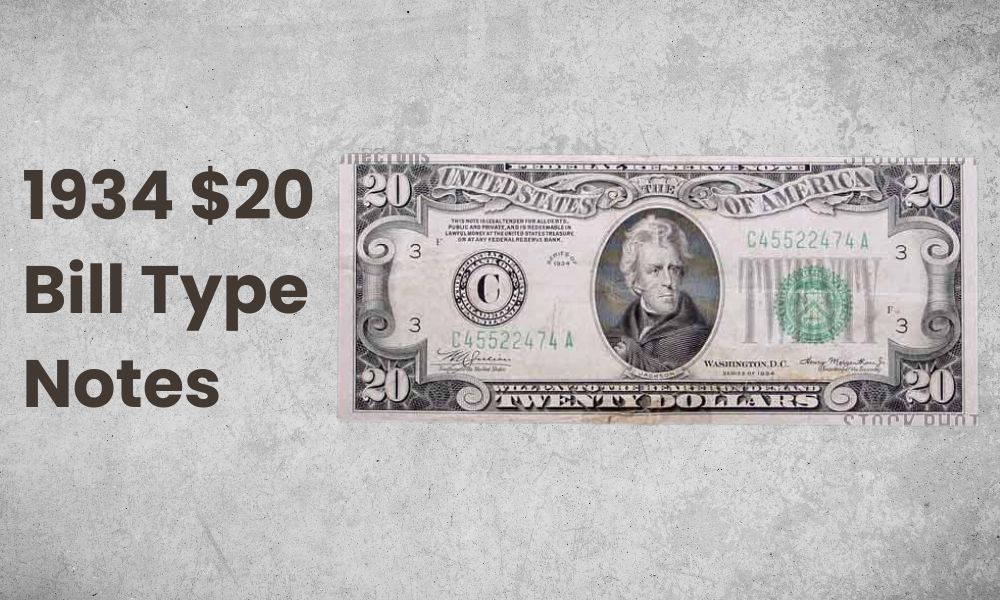
- Series: 1934
- Seal Color: Green
- Face Value: $20
- Dollar Value: $29.7 – $115
- Signatures: Treasury Secretary Henry Morgenthau Jr. and Treasurer William Alexander Julian
Printing of the 1934 $20 bill variety began on February 2nd. Although these notes have a face value of $20, today, their value depends on the note’s grade, costing within $29.7 for notes in very good condition to $115 for notes in uncirculated condition.
There are, however, specific 1934 $20 bills with a star in their serial number. This increases the value of the note to a higher value. While notes in fine and extremely fine grades are valued at $85 and $150, respectively, notes in uncirculated condition are worth as much as $675.
Furthermore, the 1934 $20 bill had the green seal and two signatures, that of Treasury Secretary Henry Morgenthau Jr. and Treasurer William Alexander Julian.
1934A $20 Bill Value
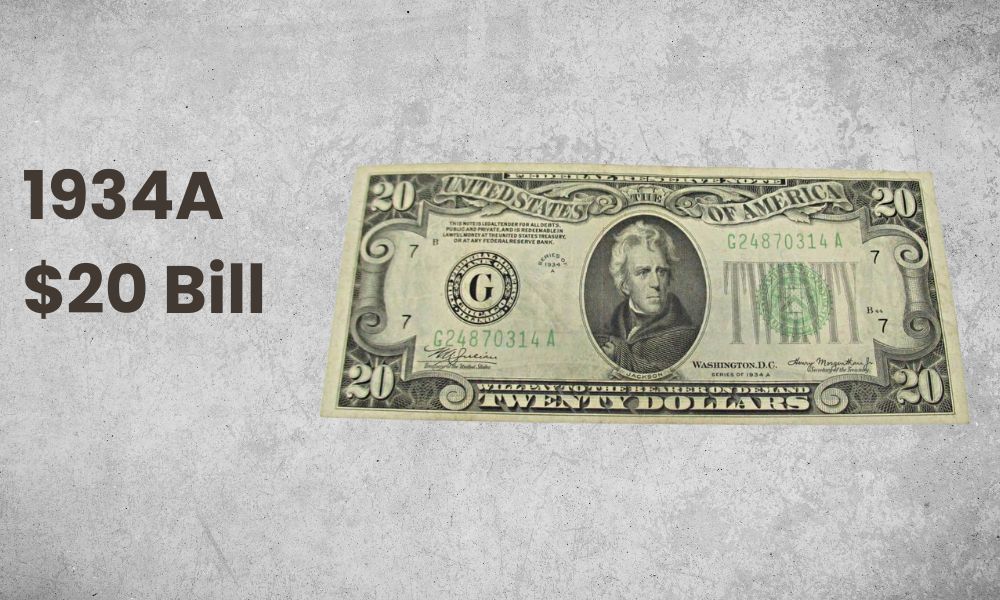
- Series: 1934A
- Seal Color: Green
- Face Value: $20
- Dollar Value: $29.7 – $74
- Signatures: Treasury Secretary Henry Morgenthau Jr. and Treasurer William Alexander Julian
The next variety of 1934 $20 bills you need to know about is the 1934A notes, whose production started circa 1938. The treasury seal on these notes is green and their worth is equal to or greater than their face value, depending on the condition of the note.
It is worth mentioning that notes in this series that possess the star in their serial number can cost as high as $350 in uncirculated condition.
1934B $20 Bill Value
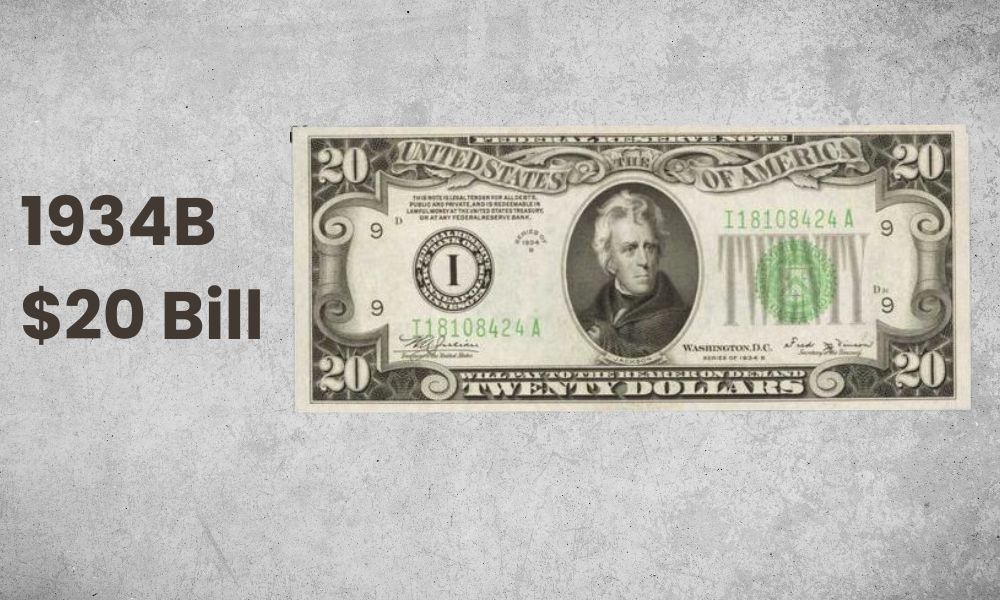
- Series: 1934B
- Seal Color: Green
- Face Value: $20
- Dollar Value: $27 – $81
- Signatures: Treasury Secretary Frederick Moore Vinson and Treasurer William Alexander Julian
The 1934B $20 bills circulated on November 9th, 1945. They featured the signatories of Treasury Secretary Frederick Moore Vinson and Treasurer William Alexander Julian.
Their worth, like other series, depends on the note’s grade and the presence of a star symbol in the serial numbering; with star notes in uncirculated condition valued as high as $650, it is worth knowing that star notes from the Federal Reserve Notes in Dallas have the highest value.
1934C $20 Bill Value
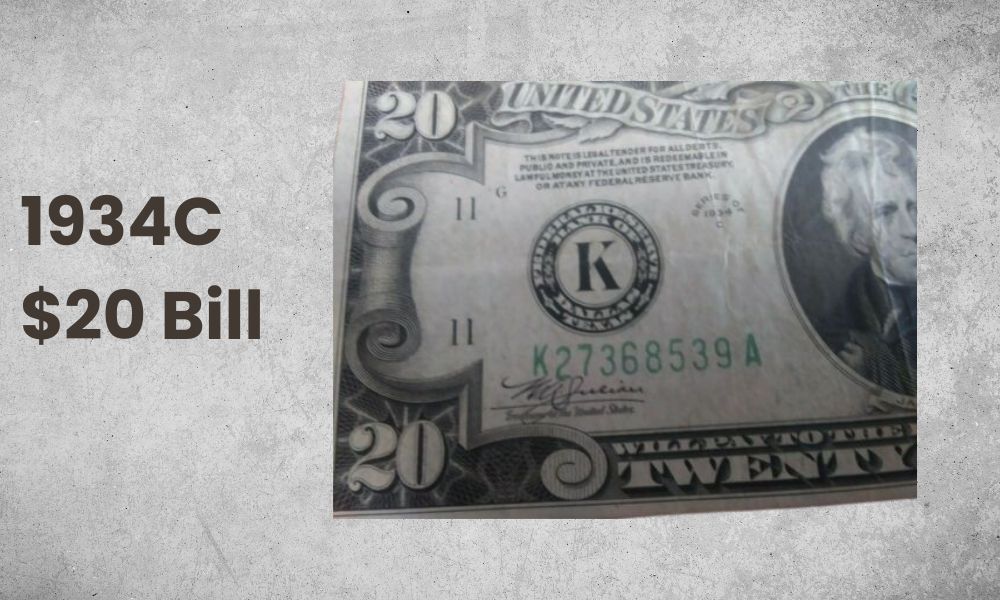
- Series: 1934C
- Seal Color: Green
- Face Value: $20
- Dollar Value: $27 – $74
- Signatures: Treasury Secretary John Wesley Snyder and Treasurer William Alexander Julian
Next is the 1934C $20 bill, whose old reverse was printed on January 7th, 1847, and the new reverse was printed on July 27th, 1948. They feature green treasury seals and the signature of Treasury Secretary John Wesley Snyder and Treasurer William Alexander Julian. Star notes in this series are worth as high as $450.
1934D $20 Bill Value
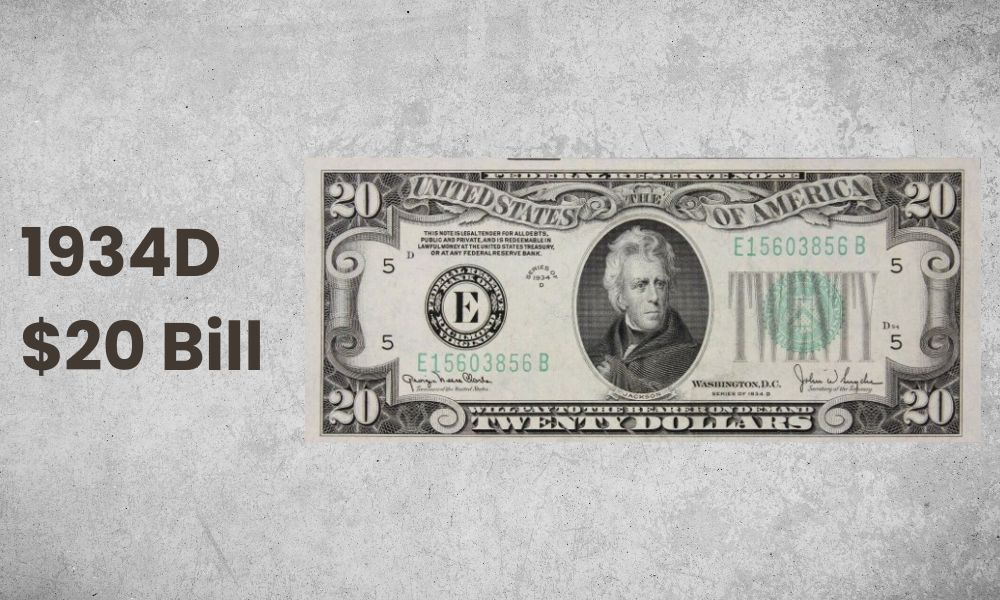
- Series: 1934D
- Seal Color: Green
- Face Value: $20
- Dollar Value: $27 – $68
- Signatures: Treasury Secretary John Wesley Snyder and Treasurer Georgia Neese Clark Gray
The 1934D $20 bill, which features signatures of Treasury Secretary John Wesley Snyder and Treasurer Georgia Neese Clark Gray, has a value of $27 – $68. These notes were printed from January 13th, 1950 to January 29th, 1951. The star note bill of the 1934D series is worth as high as $625 in uncirculated condition.
1934 $20 Hawaii Bill Value
- Series: 1934
- Seal Color: Brown
- Face Value: $20
- Dollar Value: $125 – $2500
- Signatures: Treasury Secretary Henry Morgenthau Jr. and Treasurer William Alexander Julian
This list of varieties for the 1934 $20 bill will be incomplete without the 1934 $20 Hawaii bill, specifically created to prevent the Japanese Invasion of the United States through Hawaii and the Pacific after the Pearl Harbor attack.
The strategy was that if the Japanese took Hawaii, Dollar notes they would claim would be easy to spot since they were marked “Hawaii” on both sides.
These notes, printed during WWII, had a brown seal instead of the green seal and are valued higher than other varieties from the 1934 $20 series, costing as much as a few thousand dollars.
1934A Hawaii $20 Bill Value
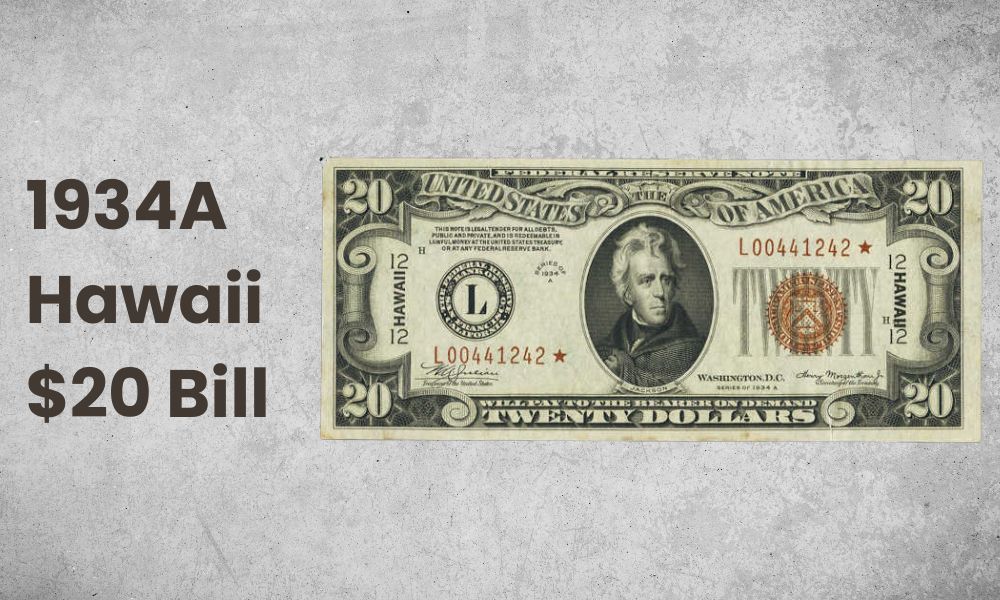
- Series: 1934A Hawaii
- Seal Color: Brown
- Face Value: $20
- Dollar Value: $110 – $775
- Signatures: Treasury Secretary Henry Morgenthau Jr. and Treasurer William Alexander Julian
The 1934A Hawaii $20 bill is another variety of the Hawaiian series worth at least $110 for notes in good grade condition and $775 if they are in uncirculated condition. Finding a star note in this series is a scarce find worth a few thousand dollars.
1934 $20 Bill History
The history of the 1934 $20 bill, which features the portrait of the 7th President of the United States, dates to 1928 when this small dollar bill was created. It coincided with the 100th anniversary of Andrew Jackson’s election as president of the United States. However, we need to determine if this was a significant factor in determining whose face would grace the new $20 bill.
Furthermore, featuring an image of the 7th president of the United States of America is ironic since, He, Andrew Jackson, opposed the National Bank and the use of paper as money. It is said that Jackson made it the goal of his administration to the National Bank, which he succeeded in attaining.
When his face was chosen as one of the few that would adorn the new dollar bills, there was a notion that there was a political motive for doing. However, the treasury disproved this and claimed that the faces chosen were because they were famous personalities.
Although in 1928, the $20 was redeemable in gold and silver at any Federal Bank Reserve at the discretion of the Bearer, in 1933, the gold standard was abandoned. The $20 bill was only redeemable in “Lawful Money”. Also, in 1942, to foil the attempt of the Japanese on Hawaii and the Pacific, the Hawaii special emergency series was created.
Over the years, the $20 bill has undergone several changes, including the motion to replace the portrait of Andrew Jackson, a known slaver, with that of Harriet Tubman, an African American. However, this is yet to take place, and the only glaring changes that have been made are
- Inclusion of the Truman balcony to the White House image on the reverse in 1948
- Replacing “Will Pay To The Bearer On Demand” with “This note is legal tender for all debts, public and private” in 1963
- Addition of anticounterfeiting features in 1992
- Complete redesign to foil counterfeiting in 1998
1934 $20 Bill Grading
1934 $20 bill is made of special paper with security features that prevent counterfeiting. Although there is a wide variety of these bills in circulation, you must certify the bill’s grade to get a good deal off one. 1934 $20 bill are divided into good, very good, fine, very fine, extremely fine, about circulated and crisp circulated notes.
1934 $20 Bill List of Errors
1934 $20 bills aren’t without mistakes. This section looks at the most common errors noticed in these bills.
1. Mismatch 1934 $20 Serial Number Error
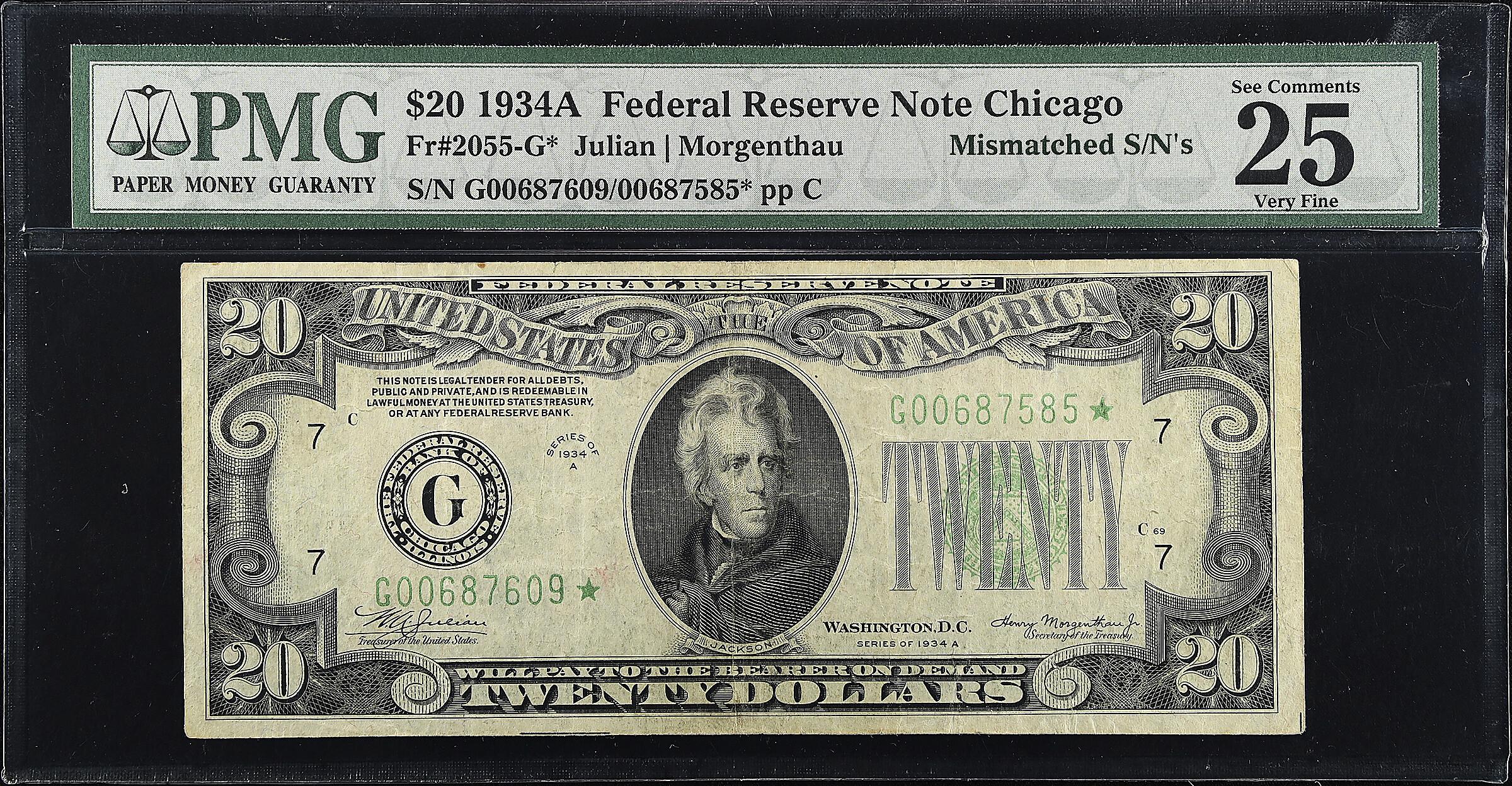
Mismatch serial number errors occur when the serial numbers on a dollar bill do not match. This error could be manual or mechanical. Although several were caught before the 1934 $20 bills were circulated, some went unnoticed, hence notes with these errors are valued as high as $500.
1934 $20 Bill FAQs
How much is a 1934 $20 bill worth today?
Today the value of a 1934 $20 bill will be worth at least its face value of $20. However, depending on the serial number, bill type, grade, and presence of error, the value could rise to above $100 and more.
How do I know if my $20 bill is rare?
One sure way to tell if your 1934 $20 bill is rare is by examining the serial number; the lower the serial number, the rarer the bill.
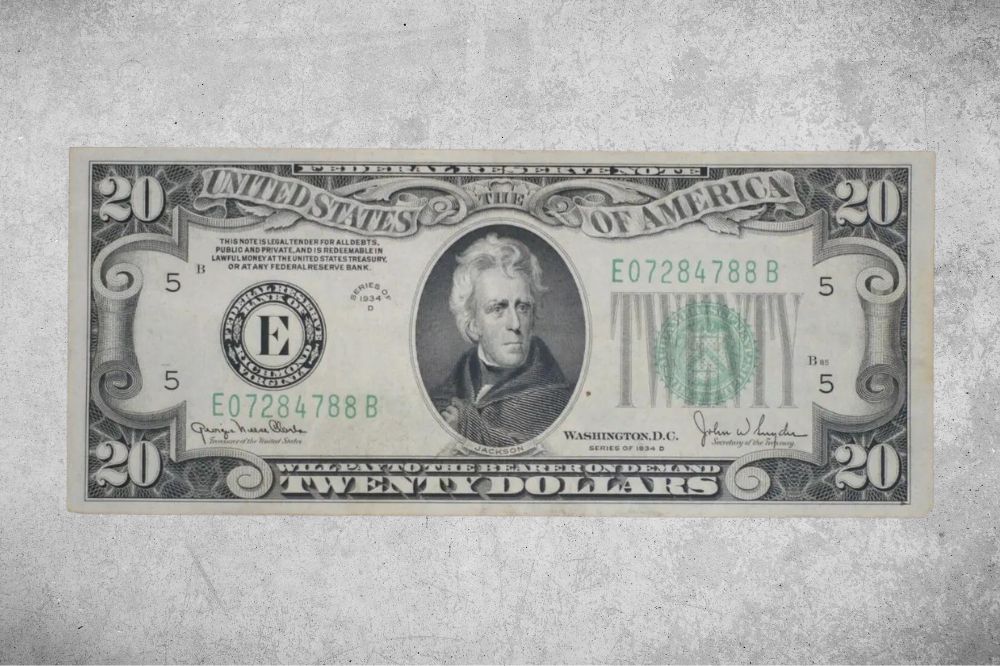
The attack on Pearl Harbor was on December 7, 1941.
This entire section makes no sense:
“This list of varieties for the 1934 $20 bill will be incomplete without the 1934 $20 Hawaii bill, specifically created to prevent the Japanese Invasion of the United States through Hawaii and the Pacific after the Pearl Harbor attack.
The strategy was that if the Japanese took Hawaii, Dollar notes they would claim would be easy to spot since they were marked “Hawaii” on both sides.
These notes, printed during WWII, had a brown seal instead of the green seal and are valued higher than other varieties from the 1934 $20 series, costing as much as a few thousand dollars.”
It makes perfect sense if you ignore the part about “after the pearl harbor attack”. The navy base there existed long before WWII, and we all knew it was the prime target for the Japanese or any other belligerent who wanted to attack the US from the west. So clearly someone just didn’t bother to check the date.